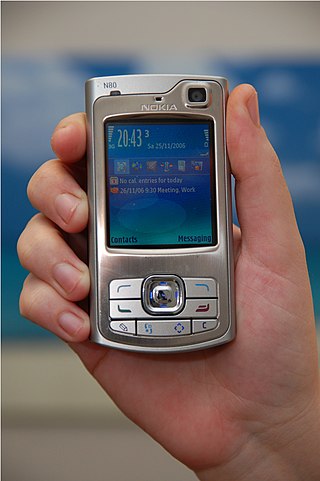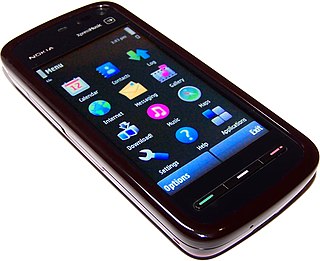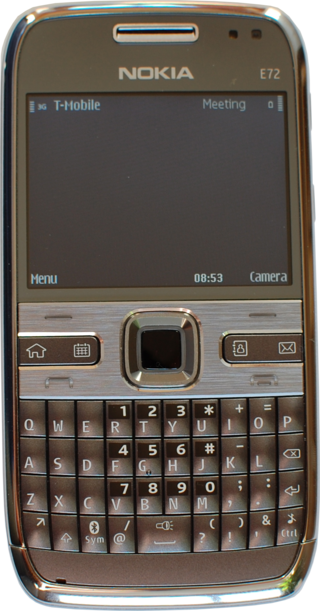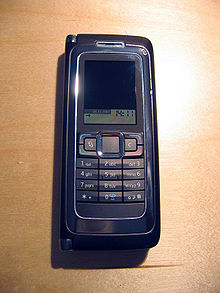
The S60 Platform was a software platform for smartphones that runs on top of the Symbian operating system. It was created by Nokia based on the 'Pearl' user interface from Symbian Ltd. It was introduced at COMDEX in November 2001 and first shipped with the Nokia 7650 smartphone. The platform has since seen 5 updated editions. Series 60 was renamed to S60 in November 2005.

Nokia 9500 Communicator is a mobile phone produced by Nokia, introduced on 24 February 2004 and released in November 2004. It runs on the Symbian-based Series 80 platform.
Nokia's Series 80 was a short-lived mobile software platform for their enterprise and professional level smartphones, introduced in 2000. It uses the Symbian OS. Common physical properties of this Symbian OS user interface platform are a screen resolution of 640×200 pixels and a full QWERTY keyboard. Series 80 used the large size of the Communicator screens to good effect, but software had to be developed specifically for it, for a relatively small market.
Nokia Browser for Symbian was the default web browser for the S60 and Symbian mobile phone platform. The browser is based on a port of Apple Inc.'s open-source WebCore and JavaScriptCore frameworks which form the WebKit rendering engine that Apple uses in its Safari Web browser.

The Nokia N80 is a 3G mobile phone from Nokia announced on November 2, 2005, part of the multimedia Nseries line. It runs on Symbian OS v9.1 and the S60 3rd Edition interface. It was first released in June 2006.

The Nokia N95 is a mobile phone produced by Nokia as part of their Nseries line of portable devices. Announced in September 2006, it was released to the market in March 2007. The N95 ran S60 3rd Edition, on Symbian OS v9.2. It has a two-way sliding mechanism, which can be used to access either media playback buttons or a numeric keypad. It was first released in silver and later on in black, with limited edition quantities in gold and purple. The launch price of the N95 was around €550.

The Nokia N73 is a mobile phone announced by Nokia on 2006 as part of the Nseries and started shipping on 15 July. The N73 succeeded the N70 and packed in numerous multimedia features. It features a 3.2 megapixel autofocus camera, a front camera, a then-large 2.4-inch display, and stereo speakers, all in a relatively slim and pocketable size and form. It runs on Symbian v9.1. An improved, music-focused version called N73 Music Edition was released in 2007.

The Nokia 6110 Navigator is a mobile phone made by Nokia, announced on 12 February 2007. It has been available since June 2007. It runs on Symbian OS v9.2 with a S60 3rd Edition FP1 user interface. It is not to be confused with the 1997/98 Nokia 6110. The Nokia 6110 Navigator includes pre-loaded navigation maps.

The Nokia 6120 classic is a mid-range mobile phone from Nokia that was announced on 17 April 2007. It runs on Symbian v9.2 with a S60 3rd Edition FP1 user interface.

The Nokia E71 is a mobile phone introduced on 8 May 2008 from the Eseries range with a QWERTY keyboard targeting business users worldwide. It runs on Symbian OS v9.2, with a Series 60 3rd Edition, second generation Feature Pack 1. The Nokia E71 succeeded the Nokia E61/61i models, building on the base design and form factor but enhancing on the feature set.

Nokia 5800 XpressMusic is a smartphone part of the XpressMusic line, announced by Nokia on 2 October 2008 in London and started shipping in November of that year. Code-named "Tube", it was the first touchscreen-equipped S60 device by Nokia – essentially it was the first device to run Symbian^1, also known as S60 5th Edition, the touch-specific S60-based platform created by the Symbian Foundation. The touchscreen features tactile feedback.
The Nokia 6650 fold is a Nokia mobile phone announced in March 2008, running Symbian OS. It is a Hex-band unit using GSM 850, 900, 1,800, and 1,900 MHz networks and UMTS 850 and 2,100 Mhz networks. Also noted as a quad-band clamshell 3G smartphone, it was released in June 2008. It was sold through AT&T Mobility in the U.S. It is AT&T's replacement for the S60-powered N75. It was manufactured in three colors, metallic silver, black, and red. It was never a global model, and therefore it was sold exclusively for T-mobile networks in Europe. Models were RM-324 for North America and RM-400 for Europe.

The Nokia N97 is a high-end smartphone introduced on 2 December 2008 by telecommunications manufacturer Nokia as part of its Nseries and released in June 2009 as the successor to the Nokia N96 phone. The N97 was Nokia's second S60-based touchscreen phone, after the Nokia 5800 XpressMusic. The device featured slide-out QWERTY keyboard, and ran on the Symbian v9.4 operating system. Its design took cues from the Nokia N79. A smaller and lower-cost variant, the Nokia N97 mini, was later released.
The Nokia 6210 Navigator is a mobile phone made by Nokia that is a successor to Nokia 6110 Navigator. It was announced on February 11, 2008 and had been available from July 2008. It runs on Symbian OS v9.3 with a S60 3rd Edition FP2 user interface.

The Nokia E63 is a mobile phone announced on 12 November 2008 and released later that year. It is based on Symbian's S60 software platform and is considered a budget business smartphone positioned below the Nokia E71, featuring a plastic body instead of metal. Many of the specifications are identical to the E71 except for the lack of GPS and infrared, a lesser RAM, lack of HSDPA and lower-resolution camera with a fixed-focus lens. The E63 does come with a flashlight function using the camera flash, which is not present in the E71. It also has a more standardized 3.5 mm audio jack whereas the E71 uses a 2.52 mm jack as used on older Nokia phones. The E63 retailed for about 199 euros before taxes. The device was succeeded by the Nokia E5, but remain in production until its discontinuation in late 2011 in favour of Nokia's Lumia lineup.

The Nokia N86 8MP is a high-end mobile phone with emphasis on the camera. It was announced on 17 February 2009 and released in May 2009 as part of the Nseries. It runs on Symbian OS 9.3 and shares similar design features with the N97. Its name references the camera's megapixel count.

The Nokia E72 is a mobile phone from the Nokia Eseries range manufactured in Finland. The Nokia E72 was announced on June 15, 2009 at the Nokia Connections 2009 event in Singapore. It is the successor to the Nokia E71 and is based on a similar design and form factor, and offers a similar feature set. The Nokia E72 is a business-oriented phone and has standard features including mobile email, calendar and instant messaging among many others with its Symbian-based S60 3rd Edition Feature Pack 2 operating system.

Symbian is a discontinued mobile operating system (OS) and computing platform designed for smartphones. It was originally developed as a proprietary software OS for personal digital assistants in 1998 by the Symbian Ltd. consortium. Symbian OS is a descendant of Psion's EPOC, and was released exclusively on ARM processors, although an unreleased x86 port existed. Symbian was used by many major mobile phone brands, like Samsung, Motorola, Sony Ericsson, and above all by Nokia. It was also prevalent in Japan by brands including Fujitsu, Sharp and Mitsubishi. As a pioneer that established the smartphone industry, it was the most popular smartphone OS on a worldwide average until the end of 2010, at a time when smartphones were in limited use, when it was overtaken by iOS and Android. It was notably less popular in North America.

The Nokia 5230 is a smartphone manufactured by Nokia, running Symbian OS v9.4, S60 5th Edition. It was released in November 2009 after being announced in August of the same year.

Here WeGo is a web mapping and satellite navigation software, operated by HERE Technologies and available on the Web and mobile platforms. It is based on HERE's location data platform, providing its in-house data, which includes satellite views, traffic data, and other location services. Maps are updated every two or three months.



















